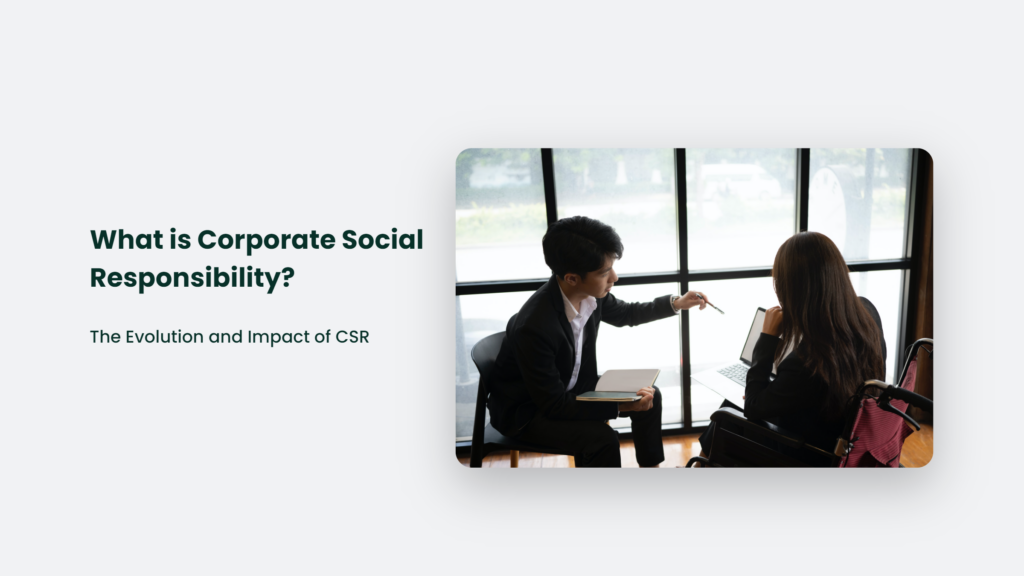

What is Corporate Social Responsibility? The Evolution and Impact of CSR

As Seen On
Corporate social responsibility (CSR) has become integral to business operations and brand management. But what is Corporate Social Responsibility, and how did it evolve into the powerful concept it is today? This article will explore corporate social responsibility’s origins, growth, and modern role.

What is Corporate Social Responsibility?
Corporate Social Responsibility (CSR) is an automated business model that helps a company be socially accountable to itself, its stakeholders, and the public. By practising CSR, a company can be conscious of its impact on all aspects of society, including economic, social, and environmental.
The Early Days of CSR
While “corporate social responsibility” only emerged in the late 1960s, the concept dates back much further. In the 1920s, businessmen like Henry Ford already recognized that treating workers well was smart business. Ford raised wages to $5 a day, helping to build a middle class that could afford his products.
Though such actions were often driven by self-interest, they laid the groundwork for a more conscious and evolved approach to business ethics. The industrial growth of the 1950s and 60s was a double-edged sword, lifting living standards while creating environmental and social problems. It fueled an expectation for businesses to consider their broader impacts.
The Era of Social Consciousness
The 1960s and 70s were a turning point, bringing social issues to the forefront of public consciousness. The civil rights movement, environmentalism, and consumer advocacy reshaped societal values.
People began demanding that companies recognize their wider responsibilities. In 1962, Rachel Carson’s book “Silent Spring” exposed the environmental damage caused by pesticides, spurring the modern environmental movement.
Milton Friedman vs. The Social Responsibility Movement
In 1970, economist Milton Friedman famously argued in The New York Times that companies should focus solely on maximizing profits. But society was moving in the opposite direction.
In 1971, the Committee for Economic Development urged executives to consider “the costs and benefits that accrue to society at large” when making decisions. The social responsibility movement was gaining momentum.
The Evolution of CSR
In the following decades, academics and businesses sought to define and implement corporate social responsibility:
- In 1979, Archie Carroll’s CSR pyramid identified economic, legal, ethical, and philanthropic responsibilities.
- In 1984, R. Edward Freeman introduced the stakeholder theory, emphasizing a company’s broad group of constituents.
- In the 1990s, the concept of corporate citizenship emerged, likening CSR to good citizenship.
The Rise of Sustainability
In 1987, the UN Brundtland Commission popularized the term “sustainable development” in a report that defined it as meeting “the needs of the present without compromising the ability of future generations to meet their own needs.”This intergenerational perspective profoundly impacted CSR. Businesses adopted the triple bottom line – people, planet, profit – as a core value. CSR is increasingly focused on environmental sustainability.
CSR Goes Mainstream
By the 2000s, CSR was widely embraced. Surveys found that most executives viewed it as central to competitiveness.
In 2008, the financial crisis and climate change made CSR more relevant than ever. Consumers and governments expected businesses to help address pressing global issues.
The Modern Role of CSR
Today, CSR is an integral part of business and brand strategy. According to a 2021 survey, 90% of consumers expect companies to behave responsibly. Let’s look at some key drivers and components of modern CSR:
Meeting Stakeholder Expectations
- Employees want to work for responsible companies and expect CEOs to speak out on social issues.
- Customers increasingly buy based on values and will pay more for responsible brands.
- Investors factor CSR into decisions. 75% of asset managers apply ESG principles to at least half of their portfolios.
The Rise of Social Enterprises
Many companies now pursue social missions, integrating CSR into their business models. For example, TOMS Shoes donates a pair of shoes for every pair sold.
CSR Activities and Reporting
Typical CSR efforts include:
- Philanthropy and volunteer programs
- Responsible supply chain management
- Reducing environmental impacts
- Supporting fair labor practices and human rights
- Promoting diversity, equity, and inclusion
Most large companies publish annual CSR or sustainability reports detailing their efforts. External ratings like the Dow Jones Sustainability Index also evaluate CSR performance.
Shared Value Creation
Some thought leaders, like Harvard professor Michael Porter, argue that CSR should focus on “shared value creation”, where social impact is integral to profitability. An example is Nestlé working with farmers to improve agricultural yields, which benefits both the farmers and Nestlé’s supply chain.
Frequently Asked Questions:
What are the benefits of CSR?
Done right, CSR provides many benefits, including improving reputation and brand image, attracting and retaining talent, appealing to socially-conscious investors and customers, boosting employee engagement, mitigating risks, and driving innovation that creates both business and social value.
Do CSR activities hurt profits?
Far from hurting profits, strategic CSR efforts are a smart business investment. They can reduce costs in areas like energy and supply chain efficiency while creating new revenue opportunities. Customers are also willing to pay more for responsible brands.
How can companies integrate CSR into their business model?
Companies can pursue shared value creation, where social impact is integral to profitability. An example is Nestlé working with farmers to improve yields, which benefits both the farmers and Nestlé’s supply chain. TOMS Shoes integrates its social mission into its business model by donating shoes for every pair sold.
The Bottom Line
CSR has evolved from an afterthought into an integral part of management strategy and brand identity. It brings a competitive advantage by attracting talent and customers, mitigating risks, and driving innovation that creates social and business value.
Rather than being a cost centre, CSR is now seen as a growth driver and a smart long-term investment. In the words of Paul Polman, former CEO of Unilever, “Business cannot succeed in societies that fail.” For companies to thrive, they must help build prosperous, just, and sustainable societies.
Konger
Up until working with Casey, we had only had poor to mediocre experiences outsourcing work to agencies. Casey & the team at CJ&CO are the exception to the rule.
Communication was beyond great, his understanding of our vision was phenomenal, and instead of needing babysitting like the other agencies we worked with, he was not only completely dependable but also gave us sound suggestions on how to get better results, at the risk of us not needing him for the initial job we requested (absolute gem).
This has truly been the first time we worked with someone outside of our business that quickly grasped our vision, and that I could completely forget about and would still deliver above expectations.
I honestly can't wait to work in many more projects together!
Disclaimer
*The information this blog provides is for general informational purposes only and is not intended as financial or professional advice. The information may not reflect current developments and may be changed or updated without notice. Any opinions expressed on this blog are the author’s own and do not necessarily reflect the views of the author’s employer or any other organization. You should not act or rely on any information contained in this blog without first seeking the advice of a professional. No representation or warranty, express or implied, is made as to the accuracy or completeness of the information contained in this blog. The author and affiliated parties assume no liability for any errors or omissions.

